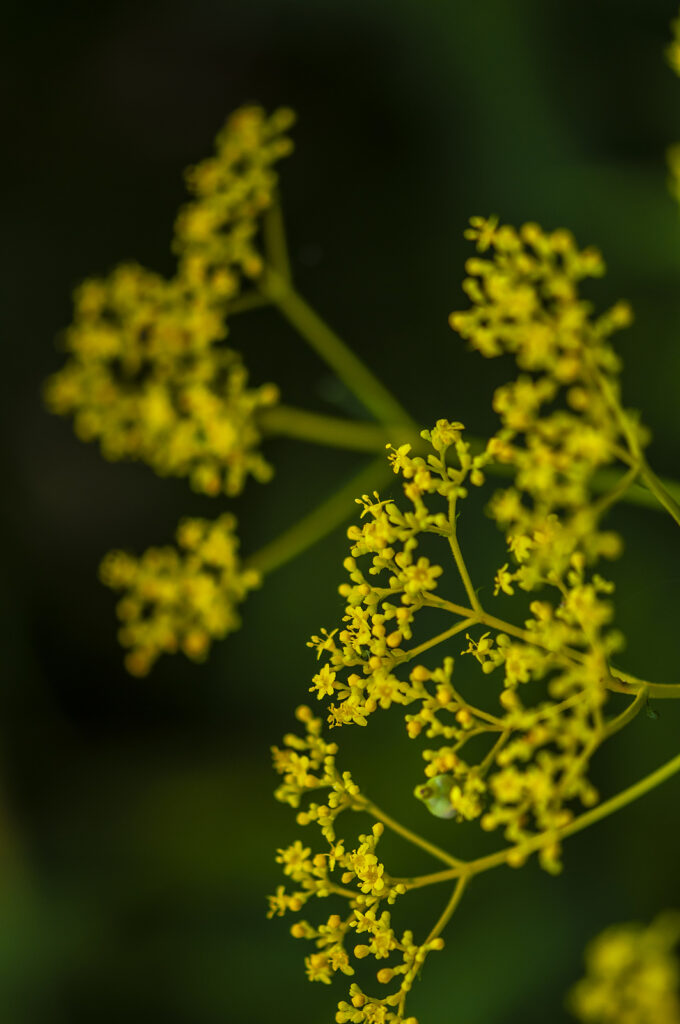Patrinia is a genus of 15 species of clump-forming perennials that bear small cup-shaped yellow or white flowers on long, usually leafless stems. Patrinia forms mounds of deeply cut or lobed leaves. The flowers appear in flat-topped clusters blooming in summer.
Patrinia are a good choice for borders, woodland gardens, and rock gardens. Patrinia can be mixed with other border perennials. They grow best in moist soil in shade or partial shade.
Patrinia are native to grassy mountain habitats in Japan and Siberia.
Get to know Patrinia
- Plant type: Perennial
- Growing zones and range: Zones 4 to 8
- Hardiness: Hardy to Zone 4
- Height and width: 8 inches (20cm) to 7 feet (1-2m) tall and 2 feet (.6m) wide depending on the variety
- Growth rate: Moderate
- Form and habit: Clump-forming
- Foliage: Mounds of deeply cut or lobed leaves that produce stems bearing few or no leaves; leaves are mainly basal, ovate to rounded, lobed, palmate, or pinnate, rarely entire, and mid- to dark green
- Flowers: Long-stemmed, sometimes corymb-like panicles of small, 5-lobed, cup-shaped, yellow or white flowers
- Bloom time: Summer and autumn
- Uses: Woodland garden, rock garden, mixed or herbaceous border, groundcover
- Garden companions:
- Uses: Blend with other border perennials that have dense flowers in hot or cool colors, such as ironweed, blanket flower, perennial sunflower, or cardinal flower
- Common name: Patrinia
- Botanical name: Patrinia
- Family name: Valerianaceae
- Origin: Siberia and Japan

Where to plant Patrinia
- Plant Patrinia in partial or deep shade.
- Plant Patrinia in fertile, humus-rich, moist soil.
- Plants tolerate heat, humidity, wind, and drought.
When to plant Patrinia
- Sow Patrinia seed as soon as ripe in containers.
- Set container grown Patrinia in the garden in spring or autumn.
Planting and spacing Patrinia
- Space plants 24 inches apart.
How to water and feed Patrinia
- Give Patrinia regular water.
- Feed Patrinia with an all-purpose organic fertilizer in spring.
How to care for Patrinia
- Patrinia need staking to remain upright, or they can be allowed to sprawl.
- Cut off faded blooms to reduce the number of self-sown seedlings.
- Do not deadhead in the first year.
Patrinia pests and diseases
- Young Patrinia leaves may be damaged by slugs and snails.
- Patrinia are otherwise usually pest free.
Patrinia propagation
- Divide Patrinia in spring every four or five years to maintain vigor; plants spread by offsets.
- Clumps can grow for years without division but can be dug and divided in either spring or fall for propagation.
- Patrinia also self sow.
Patrinia varieties to grow
- Patrinia scabiosaefolia, upright, variable perennial with leafy stems, ovate to oblong mid-green basal leaves, and pinnatifid, coarsely toothed, hairy, lobed stem leaves, 6 inches (15cm) long. From late summer to autumn, bear cymes, to 4 inches (10cm) across, in large panicles of cup-shaped, yellow flowers. To 3-7 feet (1-2.2m) tall and 24 inches (60cm) wide. East Asia.
- P. triloba, clump-forming, stoloniferous perennial with palmately 3- to 5-lobed, mid-green leaves, 2.5-4 inches (6-10cm) across, turning yellow in autumn. In mid- and late summer, branching, red-tinted stems produce panicles, to 4 inches (10cm) across, of small, fragrant, cup-shaped yellow flowers, each with a short tube and 5 spreading lobes. To 8-20 inches (20-50cm) tall and 6-12 inches (15-30cm) wide. Japan.
- P. villosa, leaves to 6 inches (15cm) long, either divided or uncut. Sprawling flower stems to 1.5 feet (.5m) hold showers of white blossoms. Full sun.



